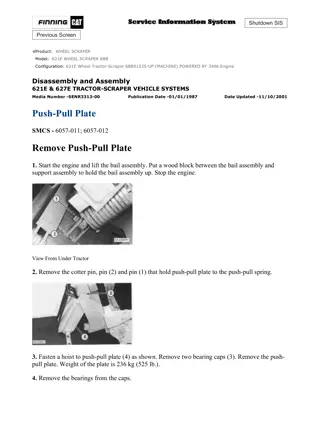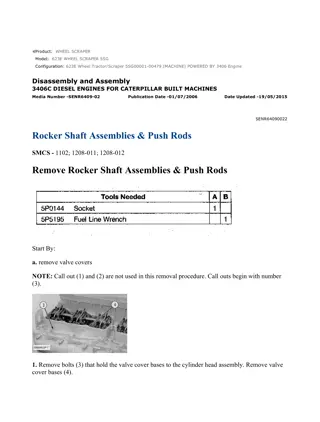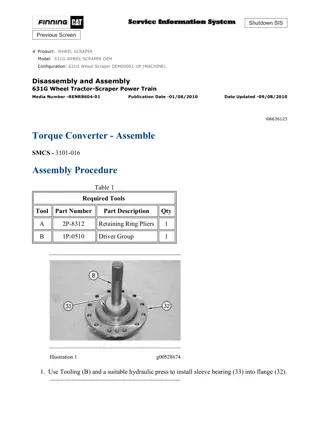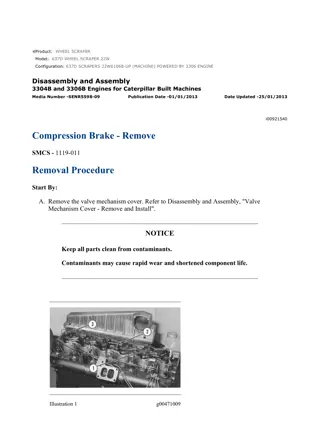
Caterpillar Cat 641 WHEEL SCRAPER (Prefix 43M) Service Repair Manual Instant Download (43M00001 and up)
Please open the website below to get the complete manualnn//
Download Presentation

Please find below an Image/Link to download the presentation.
The content on the website is provided AS IS for your information and personal use only. It may not be sold, licensed, or shared on other websites without obtaining consent from the author. Download presentation by click this link. If you encounter any issues during the download, it is possible that the publisher has removed the file from their server.
E N D
Presentation Transcript
w 1/10(W) Product: WHEEL SCRAPER Model: 641 WHEEL SCRAPER 43M Configuration: 641 SCRAPER 43M00001-UP (MACHINE) Disassembly and Assembly AIR/OIL SUSPENSION SEAT Media Number -REG01569-00 Publication Date -01/07/1992 Date Updated -10/10/2001 Air/Oil Suspension Seat SMCS - 7324-16; 7324-15 Disassemble Air/Oil Suspension Seat start by: a) remove air/oil suspension seat and air powered hydraulic pump 1. Move the seat cushion forward. Remove nut (1) that holds the cylinder to the seat support. Install a 12 in. (30.5 cm.) block at the rear of the seat. Move the cylinder free of the seat support. https://127.0.0.1/sisweb/sisweb/techdoc/techdoc_print_page.jsp?returnurl=/sisweb/sis... 2021/11/17
w 2/10(W) 2. Remove the inside snap rings from pivots (2) and (3). Remove the two pivots. 3. Remove bolts (4) that hold hydraulic panel to the base. 4. Move the hydraulic panel forward as far as possible. Remove pin (7) from linkage (5) with a hammer and punch. Remove the washer. 5. Remove the screws from the clips that hold oil lines (8) at the rear of the base. 6. Move hydraulic panel (6) free of linkage (5). Remove the hydraulic panel. 7. Disconnect oil lines (9) and (11) from cylinder (10). Remove nut (12) and the washer. Remove the cylinder. https://127.0.0.1/sisweb/sisweb/techdoc/techdoc_print_page.jsp?returnurl=/sisweb/sis... 2021/11/17
w 3/10(W) 8. Remove nuts (13), washers and the bolts that hold the valve to the hydraulic panel. 9. Remove valve and rocker assembly (14). 10. Remove cylinder rod (15) from cylinder (10). 11. Remove two seals (16) from the cylinder. 12. Remove bolts (18) and (19) that hold the seat support to the linkages. Remove three bolts (17) that hold the upper cushion to the bracket. 13. Remove seat support (20). Remove the two springs from under the support. https://127.0.0.1/sisweb/sisweb/techdoc/techdoc_print_page.jsp?returnurl=/sisweb/sis... 2021/11/17
https://www.ebooklibonline.com Hello dear friend! Thank you very much for reading. Enter the link into your browser. The full manual is available for immediate download. https://www.ebooklibonline.com
w 4/10(W) 14. Remove nuts (23) and the bolts that hold brackets (21) and (25) to the base. 15. Remove bolts (24), nuts and washers that hold lever assembly to the base. Remove lever assembly (22). 16. Remove four snap rings (32). Remove shaft (33). Remove bracket (31). 17. Remove snap ring (29) and shaft (26) that hold the inner and outer levers together. Remove two levers (30). Remove inner lever (27) from outer lever (28). 18. Remove two bearings (34) from levers (30) with tooling (B). 19. Remove the bearings from the inner and outer levers with tooling (B). https://127.0.0.1/sisweb/sisweb/techdoc/techdoc_print_page.jsp?returnurl=/sisweb/sis... 2021/11/17
w 5/10(W) 20. Remove three nuts (36) and bolts from each side of the base. Remove plates (38). Remove springs (37) and (39). 21. Remove blocks (41). Remove links (35) and (40). 22. Remove the bearings from the links with tooling (A). Assemble Air/Oil Suspension Seat 1. Install the bearings in the links with tooling (A). 2. Put links (1) and (4) in position on the base. Put block (6) in position on the links. Install springs (2) and (5). Put plate (3) in position on the bolts. Install the washers and nuts that hold the plate. 3. Install the bearings the inner lever (7) and the outer lever with tooling (B). 4. Install the bearings in the two levers with tooling (B). https://127.0.0.1/sisweb/sisweb/techdoc/techdoc_print_page.jsp?returnurl=/sisweb/sis... 2021/11/17
w 6/10(W) 5. Put the inner lever in position in outer lever (8). Put levers (10) in position between the inner and outer levers. 6. Install shaft (9) that holds the two levers and the inner and outer levers together. Install the snap ring on the shaft. 7. Put bracket (12) in position between the two levers. 8. Install shaft (11) that holds the bracket. Install the four snap rings on the shaft. 9. Put the lever assembly in position on the base. 10. Install the bolts, washers, and nuts that hold links (13) to the base. 11. Put a 12 in. (30.5 cm.) high block in position at the rear of the lever assembly. https://127.0.0.1/sisweb/sisweb/techdoc/techdoc_print_page.jsp?returnurl=/sisweb/sis... 2021/11/17
w 7/10(W) 12. Put brackets (14) and (15) in position on the base. Install bolts (16) that hold the brackets to the base. 13. Pull up on the lever assembly to get the two brackets in their top position. Tighten bolts (16) evenly to a torque of 45 to 50 lb.ft. (6.2 to 6.9 mkg). 14. Check to see that the lever assembly moves up and down freely. If the lever assembly does not move freely, loosen bolts (16) and repeat Step 13. 15. Install springs (19) and (20) on the bottom of the seat. 16. Put seat (17) in position on the lever assembly. Install the bolts that hold it. Put bracket (18) in position on the seat. Install the bolts that hold it. 17. Put valve (21) and rocker assembly in position on the hydraulic panel. 18. Install the bolts, washers, and nuts that hold the valve to the hydraulic panel. 19. Install two seals (23) in the cylinder. https://127.0.0.1/sisweb/sisweb/techdoc/techdoc_print_page.jsp?returnurl=/sisweb/sis... 2021/11/17
w 8/10(W) 20. Put the cylinder rod in position in cylinder (22). 21. Put cylinder (22) in position on the hydraulic panel. Install the washer and nut that hold it. 22. Connect oil lines (24) to their correct location on the cylinder. 23. Put hydraulic panel (26) in position on the base. 24. Install the screws that hold the clips on oil lines (25) at the rear of the base. 25. Put linkage (28) in position on the hydraulic panel. Install the washer and pin (27) that hold the linkage. 26. Make an adjustment to the position of valve so rocker (29) is .26 in. (6.6 mm) from linkage (28). 27. Install the bolts that hold the hydraulic panel to the base. Put the cylinder rod in position on the seat support. Install the nut that holds the cylinder rod to the seat support. https://127.0.0.1/sisweb/sisweb/techdoc/techdoc_print_page.jsp?returnurl=/sisweb/sis... 2021/11/17
w 9/10(W) 28. Put pivots (31) into position in the plates and over the lever. Install the snap rings that hold the pivots. NOTE: The following steps are to be used to remove and install the ride adjustment valve and the accumulator. 29. Disconnect oil line (32) and remove the connector from the valve. Remove ride adjustment valve (30) from the accumulator. 30. Remove bolts (33) from clamps (34) that hold the accumulator. 31. Remove accumulator (35) and the clamps from the hydraulic panel. 32. Put accumulator (35) and the clamps in position on the hydraulic panel. 33. Install the bolts that hold clamps (34). https://127.0.0.1/sisweb/sisweb/techdoc/techdoc_print_page.jsp?returnurl=/sisweb/sis... 2021/11/17
w 10/10(W) 34. Install ride adjustment valve (30) in the accumulator. 35. Install the connector in the valve. Connect oil lines (32) to the connector. 36. See ADJUSTMENTS TO SEAT AFTER ASSEMBLY in the TESTING AND ADJUSTING section of this manual for the correct adjustments to the seat. end by: a) install air/oil suspension seat and air powered hydraulic pump https://127.0.0.1/sisweb/sisweb/techdoc/techdoc_print_page.jsp?returnurl=/sisweb/sis... 2021/11/17
w 1/5(W) Product: WHEEL SCRAPER Model: 641 WHEEL SCRAPER 43M Configuration: 641 SCRAPER 43M00001-UP (MACHINE) Disassembly and Assembly AIR/OIL SUSPENSION SEAT Media Number -REG01569-00 Publication Date -01/07/1992 Date Updated -10/10/2001 Air Powered Hydraulic Pump SMCS - 7318-16; 7318-15 Disassemble Air Powered Hydraulic Pump start by: a) remove air/oil suspension seat and air powered hydraulic pump 1. Remove the oil from the pump. 2. Remove the bolts that hold bracket (3). Remove the bracket. 3. Remove screws (1). Remove cover (2) and the gasket. 4. Turn housing (6) and remove retainer ring (4). Remove housing (6). 5. Remove the spring and the plunger. 6. Remove connector (5) from the housing. https://127.0.0.1/sisweb/sisweb/techdoc/techdoc_print_page.jsp?returnurl=/sisweb/sis... 2021/11/17
w 2/5(W) 7. Remove piston (7) from housing (6). 8. Loosen screw (10). Remove cover (9) and filter (8). 9. Remove the O-ring seal from the screw. Remove screw (10) from the cover. 10. Remove the screen from the housing. 11. Remove the screws that hold cover (13) to the plate. 12. Remove cover (13) and oil reservoir (12). 13. Remove the bolts that hold the pump body to the plate. Remove pump body (11). 14. Remove washer (14), guide (15), spring (16), and ball (17) from the plate. 15. Remove plug (18), spring (19), and ball (20) from the rear side of the plate. 16. Inspect all parts and install new parts as needed. https://127.0.0.1/sisweb/sisweb/techdoc/techdoc_print_page.jsp?returnurl=/sisweb/sis... 2021/11/17
w 3/5(W) Assemble Air Powered Hydraulic Pump 1. Replace all O-ring seals before assembly of the pump. 2. Put the ball and spring in position in plate (1). Install plug (2) that holds the spring and ball. 3. Put the ball, spring, guide, and washer in position in the plate. 4. Put pump body (3) in position on the plate. 5. Install bolts (4) that hold the pump body to the plate. Tighten bolts (4) to a torque of 108 to 132 lb.in. (124.5 to 152.2 cm.kg). 6. Put the oil reservoir and cover (6) in position on the plate. Install screws (5) that hold the cover to the plate. 7. Tighten screws (5) to a torque of 36 to 60 lb.in. (41.5 to 69.2 cm.kg). https://127.0.0.1/sisweb/sisweb/techdoc/techdoc_print_page.jsp?returnurl=/sisweb/sis... 2021/11/17
w 4/5(W) 8. Put piston (7) in position in the housing. 9. Install the screen in housing (8). Put the filter in position on the housing. 10. Put the screw in position in cover (9). Install the O-ring seal on the screw. 11. Put cover (9) in position on the housing. Tighten the screws that hold the cover. Install connector (10) in the housing. 12. Put plunger (12) and spring (11) in position on the pump body. 13. Put housing (8) in position on the pump body. Put retainer ring (13) in position on the pump body. 14. Turn the housing to install the retainer ring. Turn the housing until the hole in the pump body and the hole in the housing are in alignment. 15. Put 8H5137 Gasket Sealer on the inside surface of gasket (15). https://127.0.0.1/sisweb/sisweb/techdoc/techdoc_print_page.jsp?returnurl=/sisweb/sis... 2021/11/17
w 5/5(W) 16. Put cover (16) in position on the housing. Make sure the holes in the gasket are in alignment with the holes in the housing. Make sure the slot in the gasket is in alignment with small hole (14) in housing. 17. Install the screws that hold the cover to the housing. Tighten the screws to a torque of 12 to 24 lb.in. (13.8 to 27.7 cm.kg). 18. Put bracket (17) in position on the pump. Install the bolts that hold it. 19. See OIL LEVEL: CHECK AND FILL in the TESTING AND ADJUSTING section of this manual for the correct procedure on filling the pump with oil. end by: a) install air/oil suspension seat and air powered hydraulic pump https://127.0.0.1/sisweb/sisweb/techdoc/techdoc_print_page.jsp?returnurl=/sisweb/sis... 2021/11/17
w 1/18(W) Product: WHEEL SCRAPER Model: 641 WHEEL SCRAPER 43M Configuration: 641 SCRAPER 43M00001-UP (MACHINE) Disassembly and Assembly BRAKE ACTUATORS (WITH EMERGENCY AND PARKING BRAKE) Media Number -SENR2107-00 Publication Date -01/05/1980 Date Updated -11/10/2001 Brake Actuators SMCS - 4262-16; 4262-10; 4262-15 Remove And Install Brake Actuators (Tractor) https://127.0.0.1/sisweb/sisweb/techdoc/techdoc_print_page.jsp?returnurl=/sisweb/sis... 2021/11/17
w 2/18(W) 1. Remove the rubber plug from the upper end of brake actuator (1). NOTE: If the machine can be operated, start the engine and let the air pressure in the system come to normal. Put blocks in front and behind the tires and wheels so the machine can not move. Put the parking brake control valve on the dash in the "RELEASED" (OFF) position. This will put the parking and emergency brake piston (7) in the "RETRACTED" position as shown with the springs (8) under compression. Then tooling (A) can be installed to hold it in this position. If mechanical failure prevents the use of the machine to do this, shop air with a minimum pressure of 100 psi (690 kPa) can be connected to the emergency and parking brake air port and the same procedure followed. Tooling (A) can be used to retract the piston if either of the other ways can not be used. 2. Remove the rubber plug from the opening and install tooling (A) into brake actuator to fasten piston (7) in the "RETRACTED" position. 3. Release the air pressure from the system. https://127.0.0.1/sisweb/sisweb/techdoc/techdoc_print_page.jsp?returnurl=/sisweb/sis... 2021/11/17
w 3/18(W) 4. Disconnect air lines (2) from the actuator. Put identification on the lines to make sure they will be installed correctly. 5. Remove cotter pin and pin (5) to disconnect yoke (4) on brake actuator (1) from slack adjuster (6). 6. Remove nuts and washers (6) and remove brake actuator (1) from the machine. The brake actuator weighs approximately 50 lb. (23 kg). NOTE: The following steps are for the installation of the brake actuator. 7. Put brake actuator (1) in position on the machine and install washers and nuts (3). Tighten the nuts to a torque of 130 18 lb.ft. (175 25 N m). 8. Connect yoke (4) to slack adjuster (6) with pin and cotter pin (5). 9. Connect air lines (2) to brake actuator. 10. Start the engine on the machine and get the air system up to full operating pressure. 11. Move the parking brake control valve on the dash to the "RELEASED" (OFF) position so air pressure will hold piston (7) in the "RETRACTED" position as shown with springs (8) under compression. Then remove tooling (A) and install the rubber plug in the opening. 12. Make an adjustment to the slack adjuster (6) until a movement of 2.5 in. (63.5 mm) at the push rod is needed for a full brake application. NOTE: The yoke location on the push rod and slack adjuster position with respect to the actuator is correct when the slack adjuster is (perpendicular) at a right angle to the push rod at the half way point of travel. Check out brake operation completely before blocks are removed from in front of and behind the tires and wheels. Remove And Install Brake Actuators (Scraper) https://127.0.0.1/sisweb/sisweb/techdoc/techdoc_print_page.jsp?returnurl=/sisweb/sis... 2021/11/17
w 4/18(W) 1. Remove the guard (1) from over the brake actuator (2). NOTE: If the machine can be operated, start the engine and let the air pressure in system come to normal. Put blocks in front and behind the tires and wheels so the machine can not move. Put the parking brake control valve on the dash in the "RELEASED" (OFF) position. This will put the parking and emergency brake piston (4) in the "RETRACTED" position as shown with the springs (5) under compression. Then tooling (A) can be installed to hold it in this position. On the 651B Scraper it will be necessary to cut an opening in bracket (3) to permit installation of tooling (A). If mechanical failure prevents the use of the machine to do this, shop air with a minimum pressure of 100 psi (690 kPa) can be connected to emergency and parking brake air port and the same procedure followed. Tooling (A) can be used to retract the piston if either of the other ways can not be used. 2. Remove the rubber plug from the opening and install tooling (A) into brake actuator to fasten piston (4) in the "RETRACTED" position. 3. Release the air pressure from the system. https://127.0.0.1/sisweb/sisweb/techdoc/techdoc_print_page.jsp?returnurl=/sisweb/sis... 2021/11/17
w 5/18(W) 4. Disconnect air lines (6) from the actuator. 5. Remove cotter pin and pin (9) to disconnect yoke (8) from slack adjuster (10). 6. Remove nuts and washers (7) and remove brake actuator (2) from the machine. The brake actuator weighs approximately 50 lb. (23 kg). NOTE: The following steps are for the installation of brake actuator. 7. Put brake actuator (2) in position on the machine and install washers and nuts (7). Tighten the nuts to a torque of 130 18 lb.ft. (175 25 N m). 8. Connect yoke (8) to slack adjuster (10) with pin and cotter pin (9). 9. Connect air lines (6) to brake actuator. 10. Start the engine on the machine and get the air system up to full operating pressure. https://127.0.0.1/sisweb/sisweb/techdoc/techdoc_print_page.jsp?returnurl=/sisweb/sis... 2021/11/17
w 6/18(W) 11. Move the parking brake control valve on the dash to the "RELEASED" (OFF) position so air pressure will hold piston (4) in the "RETRACTED" position as shown with springs (5) under compression. Then remove tooling (A). Install the rubber plug in the opening. 12. Make an adjustment to the slack adjuster (10) until a movement of 2.5 in. (63.5 mm) at the push rod is needed for a full brake application. NOTE: The yoke location on the push rod and slack adjuster position with respect to the actuator is correct when the slack adjuster is (perpendicular) at a right angle to the push rod at the half way point of travel. 13. Install the guard (1) over the brake actuator (2). Check out brake operation completely before blocks are removed from in front of and behind the tires and wheels. Disassemble Brake Actuators start by: a) remove brake actuators https://127.0.0.1/sisweb/sisweb/techdoc/techdoc_print_page.jsp?returnurl=/sisweb/sis... 2021/11/17
w 7/18(W) The brake actuators are under compressed spring force at all times. Do not start to disassemble the actuators until the instructions are completely understood. 1. Remove yoke (3), the boot, retainer (1) and filter (2). Do not remove jam nut from the push rod at this time. 2. Make an application of pressure air [minimum of 100 psi (690 kPa)] as shown to the emergency inlet port and remove release bolt and washer. If no air is available the release bolt can be removed by hand with a wrench. NOTE: Make sure to have a press available which has a minimum throat opening (height) of 25 in. (635 mm) and a minimum stroke of 14 in. (355.6 mm). Make sure the safety shield for the press is in position during the pressing operation. NOTE: The safety shield has been removed from the press for better photo illustration. https://127.0.0.1/sisweb/sisweb/techdoc/techdoc_print_page.jsp?returnurl=/sisweb/sis... 2021/11/17
w 8/18(W) 3. Put the actuator into a press as shown. Use a 3 1/4" hex socket (5) as a spacer and make sure the adapter (4) on the press rod has a pilot on the end to fit into the end of the socket. 4. Put a light but firm pressure against the end of the emergency cylinder (6). Make sure just enough force is kept on the actuator, and remove bolts (7) that fasten emergency cylinder (6) and service cylinder (8) to the center support. 5. Slowly retract the press to permit the spring force to be released completely. 6. Remove emergency cylinder (6), inner spring (9), outer spring (10), parking and emergency piston assembly (11) and center support (12) from service cylinder (13). https://127.0.0.1/sisweb/sisweb/techdoc/techdoc_print_page.jsp?returnurl=/sisweb/sis... 2021/11/17
Suggest: For more complete manuals. Please go to the home page. https://www.ebooklibonline.com If the above button click is invalid. Please download this document first, and then click the above link to download the complete manual. Thank you so much for reading
w 9/18(W) 7. Remove service piston assembly (17), return spring (16), spring locator (15) and jam nut (14) as a unit from service cylinder (13). 8. Hold force of spring (16) away from jam nut (14) and remove the jam nut, spring locator (15) and the spring from piston assembly (17). 9. Remove the screws that fasten service packing retainer (18) to the piston and remove the retainer. 10. Remove packing cup (19) from the piston. NOTICE Be very careful when piston bearings (20) and (22) are removed from the pistons to prevent damage to the pistons. https://127.0.0.1/sisweb/sisweb/techdoc/techdoc_print_page.jsp?returnurl=/sisweb/sis... 2021/11/17
w 10/18(W) 11. Use a hammer and chisel as shown to break (split) piston bearing (20) and remove it from the service piston. Remove the sealing compound from the piston. 12. Remove screws (21), retainer (22) and parking cup (23) from piston (11). 13. Use a hammer and chisel as shown to break (split) piston bearing (24) from the emergency piston. Remove the sealing compound from the piston. 14. Remove O-ring seals (25) from center support (12). 15. Use tool (A) and remove snap ring (26), bushing (27) and O-ring seal (28) from center support. Assemble Brake Actuators https://127.0.0.1/sisweb/sisweb/techdoc/techdoc_print_page.jsp?returnurl=/sisweb/sis... 2021/11/17
https://www.ebooklibonline.com Hello dear friend! Thank you very much for reading. Enter the link into your browser. The full manual is available for immediate download. https://www.ebooklibonline.com





















